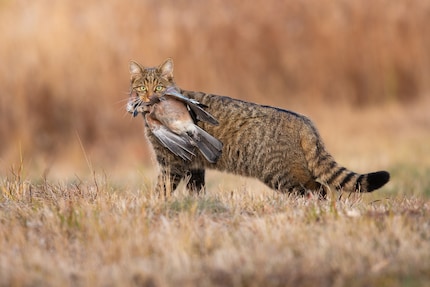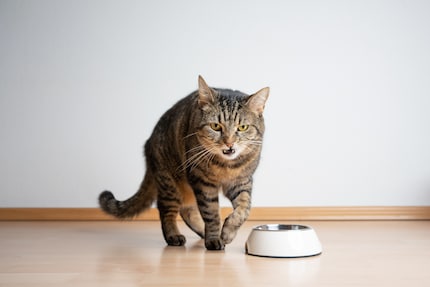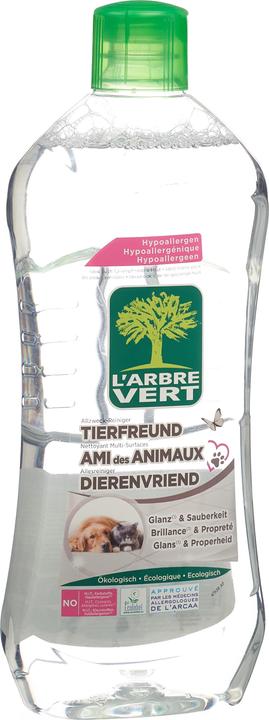

Yum or yuck? Why cat’s change their food preferences
Cats know exactly what they want – until they don’t. Some felines have been known to snub their favourite food from one day to the next. Here are 8 reasons why and how to handle it.
Mixed poultry in gravy. Until yesterday, that was my cat’s favourite food. Today, she’s turning her nose up in disgust at this luxurious meal. And I’m knitting my brows. What’s going on? Did she just change her taste overnight?
The wild’s to blame
Yup, turns out this can happen. Take a closer look at cats’ ancestors and you’ll see why. Out in the wild, changing food preferences makes sense. Relying on several sources of food means those wild felines can switch to alternatives if one of them’s no longer available. So for survival, wild cats change their diet from time to time. But only often enough to keep the risk of being poisoned by something new to a minimum.

Source: Shutterstock/WildMedia
However, your cat’s heritage doesn’t always explain why it’s refusing to eat. The problem often lies in the present day and within your own four walls:
1. A bad experience
Maybe you fed your cat its favourite food just before taking it to the vet for a jab? Or maybe your fur ball was sick after eating? Perhaps somebody made him or her jump or disturbed them while eating? Cats register these kinds of things and associate bad experiences with their food.
2. A horrible smell
Has your cat’s food been out for too long and is starting to smell? Maybe you’re using a new cleaning product around the food bowl? That could be the reason your feline friend’s avoiding its favourite food.
3. The feeding bowl
Have you introduced a new bowl? Maybe it’s too narrow and your cat’s sensitive whiskers are touching the sides. This can cause so-called whisker stress over time.
4. Too much
Has the neighbour started feeding your cat? Maybe you left the cat food out all day? Or you’re feeding your kitty snacks in between? All of the above might just be making that favourite food less attractive.
5. The heat
It’s not just hot summer weather, but also the internal fire your cat’s feeling when she’s in heat that might be curbing her appetite. Maybe that’s why she’s gone off her food.
6. The cold
Did your cat’s favourite food come straight out of the fridge? If so, the flavour may be weaker and your cat may not be impressed with the smell of it.
7. A new composition
It’s also possible that the cat food manufacturer’s made a change to the recipe. Cats that react sensitively to this may avoid the «new» food. Maybe you’ve added nutrients to the meal and made it taste differently.
8. Sickness
If your furry friend’s gone off it’s favourite, or indeed any food, for several days, you should go to the vet. Wet food in particular is an important source of water, which your cat will lack if it stops eating. So don’t wait too long before making that appointment.

Source: Shutterstock/Nils Jacobi
Verdict
There’s not much you can or should do about a cat’s natural need to randomly change its food preferences. However, if you change the food you serve too often, i.e. every few days or more, this might turn your cat into a fussy eater. Remember to slow down if you want to introduce a new type of dish after a few weeks or months or are forced to get your cat used to new food. For example, by mixing one or more spoons of the new food into the old food every day until you’ve completely replaced it. This can take up to ten days to complete.
By contrast, you can work wonders with the feeding area. Pay particular attention to the following points when dealing with your food-refusing fur ball:
- Pick two quiet spots where your cat won’t be disturbed and is unlikely to have any unpleasant experiences. Why two, I hear you ask? Because food and water shouldn’t be in the same place. In the wild, water next to bits of prey could be contaminated.
- Create a positive association with the feeding area by gently stroking your cat’s back when it’s there.
- Use shallow bowls so there’s no whisker stress.
- Gently heat the food before serving to enhance the flavour.
- Don’t leave the food standing around all day, but clear it away instead.
- Feed your cat small amounts if she’s in heat or there’s warm weather.
- Go easy on the treats.
- Clean the feeding area with a new cleaning agent.
Has your pet suddenly stopped eating its favourite food? What was the reason? And what did you do about it? Let the Community know in the comments!
Header image: Shutterstock/Cat Box
I love anything with four legs or roots - especially my shelter cats Jasper and Joy and my collection of succulents. My favourite things to do are stalking around with police dogs and cat coiffeurs on reportages or letting sensitive stories flourish in garden brockis and Japanese gardens.
Practical solutions for everyday problems with technology, household hacks and much more.
Show all



